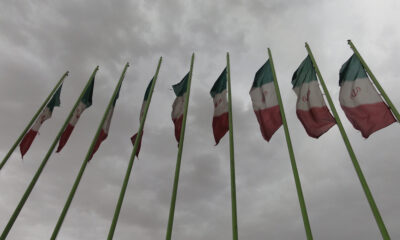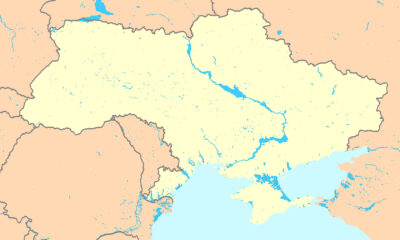Guest Columns
The Little Big War: 1967

This June will mark the 50th anniversary of one of the most important military events of the 20th century, the “Six Day War” between Israel and her Arab neighbors of Egypt, Syria, and Jordan. The reverberations of this conflict remain with us today, and have commanded the attention of a disproportionate amount of the world’s political and diplomatic capital.
A small war with big effect
This war can be seen as an episode in the history of the Jewish people that is emblematic for our role and impact in the world generally. Though a very small military action in material terms by the objective standards of military history, it’s influence was far greater than the numbers would suggest…as is typically the case for all things associated with the Jewish people.
How small was this “war” in real terms? By way of perspective, we might compare it to one of the major battles of World War Two, such as the Battle of Okinawa.
One of the decisive battles of the Pacific Theater, Okinawa lasted not six days, but nearly fourteen weeks. During this battle, just over 14,000 American servicemen were killed, while Japan lost over 77,000 military personnel. In addition, nearly 150,000 Japanese civilians also perished. By contrast, Israeli losses during the Six Day War were just under 1,000, while total Arab losses were about 4,300, the majority of which (3,000) were Egyptian; civilian casualties were negligible on both sides. In other words, American losses alone in Okinawa were more than twice the combined losses of all combatants during the Six Day War.
Before we look at the deep influences of the Six Day War at various levels, a recounting of what led up to the war, and the war itself, is in order.
Arabs never accepted Israel
First, it should be remembered that Israel’s Arab neighbors had never accepted the legitimacy of modern Israel’s founding in 1948. The very day Israel declared her official independence, she was invaded by five Arab armies. At the time, British military intelligence estimated that Israel would only hold out for three days before being overrun. Instead, Israel fought for eight months and doubled the size of the territory she had been allotted according the the UN Partition Plan of 1947. In the wake of this first of modern Israel’s wars, no formal peace agreement was signed, only an armistice that suspended active hostilities. The Arabs refused to recognize Israel and continued to arm and plan for her ultimate destruction.
From modern Israel’s founding, it had been a fundamental tenet of Israeli foreign policy to cultivate at least one major power ally who would have a permanent seat on the UN Security Council, and who would not only provide important diplomatic backing in that forum, but who would also be willing to provide Israel with the defensive arms she could not produce herself. In the immediate wake of her war for independence, that ally was France, who was later joined by – most ironically – Britain, after the 1956 Sinai Campaign.
The Sinai campaign
In a fashion similar to what we see emanating from Hamas-controlled Gaza today, Egyptian irregular forces had been launching small-scale terrorist raids into Israel from the Sinai Peninsula in the years following the 1949 War of Independence. Israel didn’t want to be seen as an aggressor, starting an all-out war, but was very keen on putting a stop to these raids once and for all.
The opportunity to do so presented itself with the Suez crisis of 1956. Egypt’s strongman dictator, Gamel Abdel Nasser, nationalized and seized control of the Suez Canal, which had been built by, and had been under the jurisdiction of, Britain and France. France and Britain wanted to reverse Nasser’s seizure of the canal, but did not want to take overt unilateral action to this end. So, they coordinated in secret with Israel for the latter to provide a pretext for taking the canal back from Egypt: Israel would invade the Sinai with the aim of clearing out guerrilla strongholds, while Britain and France, acting to “protect” the canal from the resulting hostilities, would move in and retake the same.
In exchange for Israel’s help, Britain and France promised Israel major arms support in terms of fighter aircraft and tanks. The opportunity to obtain these arms was seen as critical by Israeli leaders, as Syria and Egypt were being heavily armed by the Soviets, and the U.S. at that time refused to provide Israel with modern armaments.
Gains from that campaign
The 1956 Sinai Campaign by Israel against Egypt was a great military victory; Israel succeeded in taking the entire peninsula. However, the British and French operations to seize the canal were abortive; the U.S. under Eisenhower put the British, French, and Israelis under extreme diplomatic pressure to withdraw.
Though a humiliation for France and Britain – Egypt retained control of the canal – Israel did not come away entirely empty handed. Though forced to withdraw from the Sinai, Britain and France kept their commitments to provide Israel with arms. Moreover, in exchange for her withdrawal, Israel received security guarantees that included the demilitarization of the Sinai, along with the stationing of UN peacekeeping forces there, between Israel and Egypt. However, Israel’s demonstrated military prowess against Egypt did not bring her any closer to peace; the implacable hostility of Israel’s Arab neighbors remained, and the stage had been set for the next round.
The refugee situation
The “next round” did not actually begin in June of 1967. In fact, the immediate roots of the Six Day War were to be found in a chain of events that began in 1964. But before going into those events, a fact of vital importance must be noted here. For the first nineteen years of modern Israeli history, there was no Israeli “occupation” of “Palestinian land”, Israel’s great “sin” according to many of her detractors today. The Gaza Strip was under Egyptian control, the Golan Heights was in Syrian hands, and Judea/Samaria – aka the “West Bank” – was under Jordanian rule. Jordan’s occupation of the latter, dating from the 1949 War, was not even formally recognized as legitimate by the international community, save for Britain (and even then, this recognition excluded East Jerusalem).
Yet no attempt was made by Egypt or Jordan to provide the Palestinian Arabs in these areas with a national homeland. Instead, Palestinian Arabs – despite being racially, culturally, and linguistically all but indistinguishable from the inhabitants of Israel’s Arab neighbors – were forced to languish in refugee camps, denied basic human rights, and were essentially treated as cannon fodder to be used against Israel, not essentially different from their situation outside of Israel today. This basic, indisputable historical fact proves that the so-called “occupation” has nothing to do with the status of the Palestinian Arabs, nor their intended role in the dismantlement of Israel.
Attacks before 1967
As far back as 1953, Israel had made plans to build a pipeline from the Sea of Galilee to the Negev desert in order to aid in the development of the latter. Actual work on this project began in 1964. In response, as part of their ongoing campaign to strangle Israel by any and all means possible, Syria in particular began an engineering project to divert water away from the Sea of Galilee, so as to undermine vital water supplies for Israel. In addition, the Arab League supported the founding of the Palestine Liberation Organization, or PLO, that same year, and Syria and Jordan both sponsored PLO terrorist attacks against Israel from their respective territories. Once again, the reader here is reminded that all of this hostility directed against Israel predated the “occupation”.
Israel had no choice but to respond to these attacks. During the three years preceding the Six Day War, Israel launched a series of military actions – chiefly air attacks – against Syrian equipment being used to divert water from the Sea of Galilee, and against terrorist camps in Syria and Jordan. These strikes naturally brought Israel into direct confrontation with Syrian and Jordanian military forces, culminating in a particularly violent episode in April of 1967, during which the Israeli Air Force dropped 65 tons of bombs and shot down six of Syria’s then state-of-the-art Soviet-supplied MiG-21s.
This humiliation of the Syrians at the hands of Israel – though richly provoked by the former – led to a firm commitment by Egypt to directly support Syria in any future clash with Israel. Similar commitments were made by Egypt to Jordan in the wake of a clash between Israel and Jordan the year before. So now, a coordinated, active military alliance had been formed between Egypt, Jordan, and Syria, against Israel.
Long odds
On paper, the odds appeared very much against Israel if she had to face the combined military forces of these three countries, all at once. Total mobilized manpower available to Israel was 250,000, versus 328,000 for the Arabs. The Arabs outnumbered Israel nearly five-to-one in artillery, and well over two-to-one in both tanks and combat aircraft. At sea, Syrian and Egyptian combined naval manpower outnumbered that of Israel by three and a half to one, and naval vessels by seven to one.
Moreover, unlike today, Israel enjoyed no significant technological advantage over her adversaries; the weapons employed by both sides were of comparable performance and sophistication. In fact, Egypt in particular possessed weapons with no counterpart in Israel, such as Soviet-built Tu-16 medium bombers. Finally, and perhaps most threatening of all, tiny pre-1967 Israel had no strategic depth, consisting of a land area comparable to New Jersey, and only nine miles wide at her narrowest point. A major setback on the battlefield could well have meant the end of the Jewish State.
Egyptian provocations
In May of 1967, tensions increased still further. In direct and open violation of the ceasefire arrangements related to the 1956 Sinai Campaign, Egypt introduced major military formations into the Sinai, expelled the UN peacekeepers, and went on to order a blockade of the Strait of Tiran, a key waterway for Israel; this would have been tantamount to the Soviet Union blockading the eastern seaboard of the United States, and was, by any standard of international law, an act of war.
In response to the blockade, Israel appealed to her allies in particular and the international community in general for support in lifting the blockade; she received nothing. Instead, her principal major power ally up to that time, France, warned Israel that any major military action on her part would result in the complete withdrawal of French support. Even the United States, under the most pro-Israel president up to that time, Lyndon Johnson, warned Israel against taking action. But faced with the blockade, Egyptian military moves in the Sinai, and coordinated hostility from Egypt’s allies in Syria and Jordan, Israeli leaders decided they must act or face the real possibility of being strangled and overrun by her implacable Arab foes. And act she did.

The French-built Dassault Mirage III (known as “Shahak”, or “Skyblazer”, in Israeli service) was the principal front-line fighter used for Israel’s air campaign in 1967. Specially developed Israeli anti-runway bombs and local modifications to the gunsight made it devastatingly effective in the hands of Israeli pilots for both strike and air combat roles.
The war begins
Destruction of the Egyptian Air Force
On the morning of June 5th, 1967, the Israeli Air Force launched multiple waves of airstrikes against the Egyptian Air Force over the course of three hours. In this short span of time, approximately 300 Egyptian combat aircraft were destroyed, including all of Egypt’s Tu-16 bombers. Later that same day, Syria, Jordan, and Iraq launched air strikes against Israel; Israel promptly responded and largely wiped out the Syrian and Jordanian air forces as well, and destroyed the Iraqi base that had launched fighter bombers against Israel. All in all, in the space of ten hours, Israel had achieved complete air superiority.
Israel could then strike with her tanks and infantry into enemy territory without concern for Arab air attacks, while Israeli aircraft were now free to provide air support for the ground offensive in uncontested airspace; this latter capability served as a “force multiplier” for Israeli ground forces, offsetting Arab numerical superiority. Israeli air dominance was so complete that she even employed some light training jets to bomb and strafe Egyptian forces retreating from the Sinai.
Recapture of Judea, Samaria, and the Golan
At the onset of hostilities, through back channels, Israel implored Jordanian leaders to stay out of the conflict. However, ignoring these entreaties, Jordanian artillery shelled Tel Aviv from positions in Judea/Samaria, which led to the Israeli army facing off against Jordan there, driving their armies out, and reuniting Jerusalem.
In the north, Syria’s use of the strategic Golan Heights as a base from which to intermittently shell Israeli border communities came to an abrupt end. Not only did Israel seize the Golan, but she considered this particular high ground of such vital importance to Israeli defense that she formally annexed this area shortly after the war.
By the evening of June 10th, the last shots of the war had been fired. Israel was now in firm possession of the entire Sinai Peninsula, Judea/Samaria, and the Golan Heights. Israel had stunned the world with her victory.
Exit France; enter USA
The French government under Charles DeGaulle made good on their threats and turned against Israel, going on to become the biggest supporter of Israel’s enemies among the Western powers; this remains true to this day. Interestingly, the argument put forth among anti-Israel elements here who claim that Islamist hostility against the U.S. is due to our “support of Israel” seems to fall flat when one considers that France, where Yasser Arafat sought treatment at the time of his death, has been among the biggest targets of Islamist terrorists.
Prior to the war, Israel had been cultivating closer ties with the United States, and with the exit of France from the list of Israel’s friends on the world stage, the role of the U.S. as Israel’s strongest major power ally, an alliance now seen as a seemingly permanent fixture of international relations, began in the immediate aftermath of that war.
Aftermath
At the level of military science, the impact of the Six Day War was no less significant. For the very first time in history, a war was won primarily on the basis of superior air power. The impact on military theory and doctrine was profound, and the lessons learned were demonstrated again by the United States in Operation Desert Storm of 1991.
Though the initial Arab reaction to the war was the “Three No’s of Khartoum: No peace, No negotiations, No recognition”, Egypt’s Anwar Sadat later broke from this policy and made peace with Israel in 1979, in exchange for Israeli withdrawal from the Sinai. The formula of “land for peace” has been touted ever since as a solution to the Israeli-Palestinian conflict, but aside from the experience with Egypt, the results of subsequent land concessions have not been so encouraging. Despite Israeli withdrawals from South Lebanon, Gaza, and concessions to the Palestinians in Judea/Samaria, the prospects for peace in these theaters is as distant as ever.
Today, Israel faces a potentially existential threat from Iran, a far larger and more powerful foe than those she faced fifty years ago. There are those both outside of and inside Israel who warn that decisive pre-emptive action on Israel’s part would be foolhardy, that this would simply be more than Israel could handle. But Israel is far stronger today as well, and Israel’s foes would do well to consider how Israel surprised the world fifty years ago. I for one am fully confident that Israel’s past is prologue, and she will move from strength to strength, regardless of the challenges she faces.
-

 Education4 days ago
Education4 days agoCHAPTER 11: Critical Race Theory: A Species of the Ideological Thought Genus Marxism
Space Is No Longer the Final Frontier—Reality Is [forthcoming release May 2024] -

 Civilization3 days ago
Civilization3 days agoCHAPTER 12: Seeding Race Wars
Space Is No Longer the Final Frontier—Reality Is [forthcoming release May 2024] -

 Civilization4 days ago
Civilization4 days agoWill Trump flip New York?
-

 Education3 days ago
Education3 days agoTitle IX revision sparks State revolts
-

 Constitution2 days ago
Constitution2 days agoPrecinct Strategy scores again
-

 Clergy4 days ago
Clergy4 days agoHistorical Points Have Their Place, But That Is Not Where Your Faith Is To Stand!
-

 Education3 days ago
Education3 days agoDid the Freemasons, Illuminati, Spiritualists and Mystics establish this country?
-

 Education2 days ago
Education2 days agoThe Road Back to Normalcy Starts Where the Problem Began: College Campuses












[…] write this, the Six Day War between Israel and her Arab neighbors was underway. In one of the most stunning military campaigns of the post-WW2 era, Israel confounded her adversaries and changed the course of history in the […]